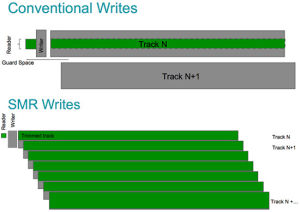MrGuvernment
Fully [H]
- Joined
- Aug 3, 2004
- Messages
- 21,797
And will cost a small fortune
http://arstechnica.com/information-...hard-drive-seagate-twiddles-shingled-fingers/
http://arstechnica.com/information-...hard-drive-seagate-twiddles-shingled-fingers/
HGST beats Seagate to market with helium-filled 10TB hard drive
WD subsidiary outs world's largest normal PMR drive. Seagate eagerly awaits HAMR.

Western Digital's HGST division has released the world's first helium-filled 10TB hard drive for everyday useassuming you have about £600 burning a hole in your pocket, anyway. Meanwhile, despite reiterating that it would have a 10TB drive on the market this year, Seagate hasn't yet moved past the 8TB mark.
The Ultrastar He10 is notable for two reasons: it's hermetically sealed and filled with helium, which is still a rather novel idea; and it has seven platters crammed into a standard-height 25.4mm (1-inch) hard drive.
Enlarge / PMR vs. SMR. With SMR, there's almost no guard space between tracks, which increases density but can reduce write speed (if you want to rewrite a track in the middle, you may also have to rewrite the adjacent tracks as well).
Seagate
The platters themselves are impressive, too: instead of using shingled magnetic recording (SMR) to boost areal density, these platters use conventional perpendicular magnetic recording (PMR). PMR has been the standard hard drive recording tech since 2005, when it replaced longitudinal recording. The move to PMR has increased the maximum platter density by an order of magnitudefrom about 100Gb per square inch to 1000Gbbut now, alas, we're beginning to hit the limits of PMR.
SMR has emerged as one possible way of increasing hard drive storage density, but the way it worksby overlapping magnetic tracks, like roofing shinglesmakes it better suited to archival or nearline use, rather than 24/7 online use.
Beyond PMR, the next recording technology to be commercialised will probably be HAMR: heat-assisted magnetic recording. Both Seagate and HGST are working on HAMR tech, which uses a laser to heat up a small region of the hard drive that's being written. The heat causes the magnetic grains to lose their superparamagnetic effect for a short period, allowing for smaller magnetic grains and higher areal density. Superparamagnetism is an annoying trait of magnetic nanoparticles where they randomly flip directiona problem when, for example, this results in your binary zeroes randomly becoming binary ones.
Enlarge / A diagram showing the basis of heat-assisted magnetic recording (HAMR).
HGST
Earlier this year, Seagate released an 8TB drive with SMR, and HGST released a 10TB SMR drive. Today's Ultrastar He10 is the first 10TB drive with PMR. Seagate hasn't yet managed to squeeze seven platters into a 3.5-inch hard drive, which appears to be why Seagate is lagging behind HGST in the capacity race. There are a few reasons why Seagate hasn't hit seven platters yet, but HGST's use of helium, which offers significantly less air resistance to the spinning platters, is probably the main one.
Both HGST and Seagate are working on HAMR drives, though Seagate has been more vocal about it, saying that it could have some HAMR drives on the market in 2016. HGST, with shingled recording and seven platters at its disposal, should have no problem hitting 15 or 20TB over the next yearbut its path towards larger online drives, using PMR or HAMR, is unclear.
![[H]ard|Forum](/styles/hardforum/xenforo/logo_dark.png)